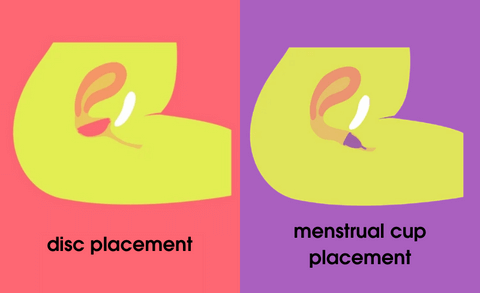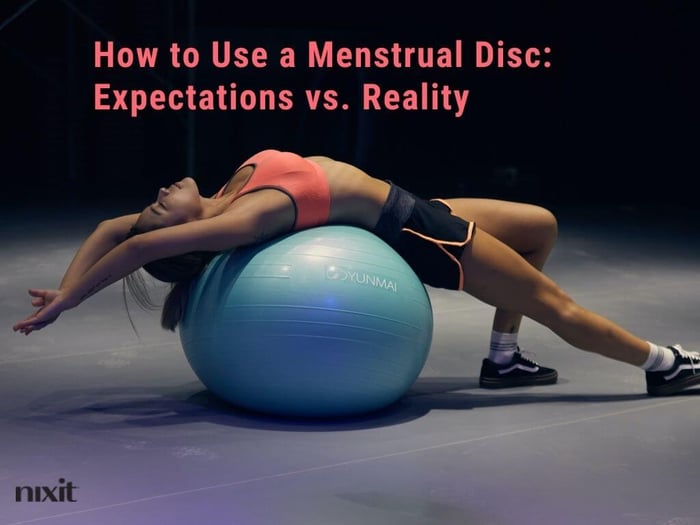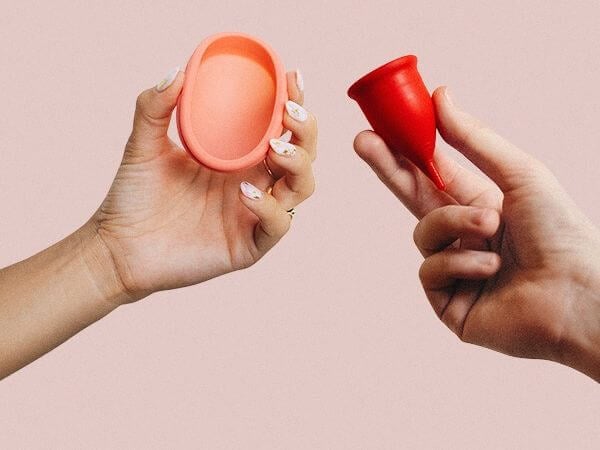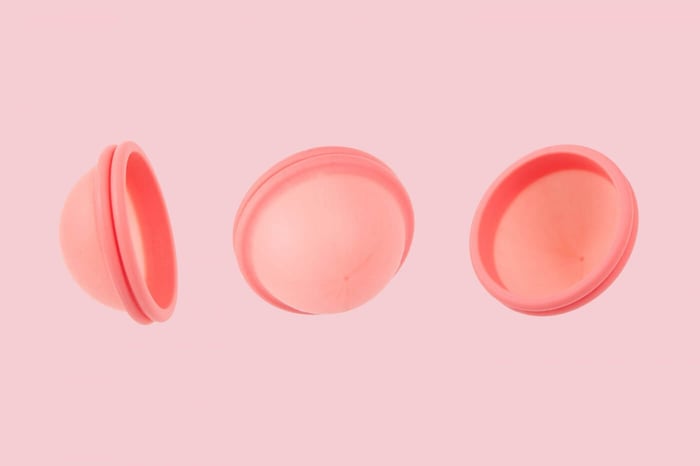Menstrual discs - you may have picked the buzzword up being shouted from the rooftops as a godsend to active people and professionals. And indeed, they can simplify your life, allowing for much more freedom than traditional menstrual products. Or maybe you’re reading this because you have no idea what this contraption everyone’s talking about is.
In short, a menstrual disc is a life-saver for those who want to simplify their periods in a sustainable way. It’s practical, convenient, and will save you money in the long run.
As a first-time user, you may not know what to expect in terms of application and removal, and use-related fears and hurdles will likely crop up.
With that in mind, the best time to troubleshoot your menstrual disc issues is before you even take it for a spin. That’s how you can ease into using it like a pro. Below is our practical guide on how to use a menstrual disc.
Menstrual Discs vs. Menstrual Cups

First, you need to tell a menstrual disc from a cup before you plunge into the whole story and learn how to use it. Both a menstrual cup and a disc collect menstrual blood inside your body and are a great sustainable alternative to tampons and pads.
Did you know menstrual cups and discs produce only a fraction of period waste (0.4%) compared to single-use pads?
They also save you wads of money compared to other menstrual products as they’re reusable (some discs aren’t and that’s something to note). But onto the differences now.
Menstrual discs sit in the vaginal fornix, further up the vaginal canal which makes them rife with usage benefits such as:
No scary suction part of insertion as the disc holds itself in place naturally (this also makes it a stress-free option for people who have an IUD)
Greater level of comfort
The possibility of penetrative sex and masturbation (it’s due to the fact that the disc sits at the base of the cervix, leaving the vaginal canal clear)
And there’s a bonus benefit tying in with the menstrual disc capacity. A menstrual disc can hold up to 4 times of what a super tampon can hold. Nifty, right?
How to Insert a Menstrual Disc? Application Explained in Four Simple Steps
New disc converts will shower you with reasons a menstrual disc has been life-changing for them, personally overlooking small anxieties that cropped up at the onset of their learning curve. Come on, seriously? Inserting a new menstrual product into your body can be darn distressing.
You may dread feeling pain, losing the disc (even though there’s nowhere for it to go!), or worse, getting the disc stuck.
But, really – what should you expect?
Before you freak out, you should know the vaginal anatomy is soft and volatile and mostly able to accommodate menstrual disc products. Human vagina is made of incredibly flexible muscles as it’s made to stretch.
If you’re new to menstrual discs, you may be obsessing over insertion. Consequently, the elevated stress can make you contract your pelvic muscles making it trickier to comfortably insert. But generally, if you follow the simple steps below, you should be fine (especially after some practice).
Step #1: Use boiling water to sterilize your menstrual disc for 5 minutes before first use.
Step #2: Wash your hands with soap and water.
Step #3: While sitting on the toilet, take some deep breaths and get as relaxed as possible.
Step #4: Pinch the disc using your thumb and forefinger. Insert the pinched disc into the vagina pushing it back and down towards your tailbone to get under the cervix as far as it’s comfortable.
Step #5: Then, using your forefinger, push the front rim and tuck the menstrual disc into place behind your pubic bone.
If things don’t go as smoothly as expected, take your time and try different positions. Try resting one foot on the toilet instead of squatting, or standing straight with both feet on the ground, or apply a small dose of a water-based lubricant during your first few experiments with the disc. Our customer service team is always available to offer more tips and tricks, too!
Check out this nixit graphic representation on how to properly insert a menstrual disc.
Info Box: What if My Menstrual Disc Starts Leaking?
You’re probably wondering, does it or doesn’t it leak? As a first-time menstrual disc user, there’s a long list of things you may dread going wrong, including leaking.
The thing is, if it’s well placed and secured nicely behind your pubic bone there shouldn’t be any leakage. All you need to do is tuck it in there (sometimes easier said than done). You should not be able to feel your disc if it is inserted correctly! If you’re worried your menstrual disc may not be inserted properly, take the disc out and put it back in.
Now, it may seem like it is leaking when using the toilet - specifically when bearing down - but this is actually just the disc self-emptying. It’s a good thing! Since your disc must be fully removed and washed at least every 12 hours, self-emptying in between can be a life-safer for people with heavy flow as this means you won’t need to manually empty your disc as frequently.
In short, pushing your pelvic muscles during bowel movement or urinating can dislodge the disc a bit, so that some of its contents are released. Once you’re done, you can push it back in, tuck it, and you’re good to go until the 12 hour mark!
The bottom line is, like with pretty much any other quotidian life skill, practice makes perfect. Once you get the hang of it, a menstrual disc can give you a 12 hours worth of protection before removing and inserting again.
Imagine all you can do during this period-safe window?
How to Remove a Menstrual Disc?
So what if a menstrual disc gets stuck in your vagina upon removal? In reality, getting a menstrual disc stuck is a rare case scenario, especially with the lack of suction. What may bring you comfort is knowing your disc has nowhere to go but out!
Removing discs may be slightly trickier than removing a tampon or a cup because there’s no string or stem to pull on. And for squeamish types, it can take some getting used to as you have to stick your finger up inside your vaginal canal to remove it.
However, nixit tips and tricks below will help you do this as swimmingly as possible.
Step #1: Wash your hands with soap and water.
Step #2: While sitting on the toilet or in the shower, gently bear down, like you are having a bowel movement, to untuck the disc from your pubic bone.
Step #3: Slide into your vagina with your index finger, hook or pinch the disc’s rim and gently pull out, keeping it as level as possible.
Step #4: Empty the contents into the toilet, wash, and reinsert (for reusable discs only).
Menstrual discs can get sort of messy upon removal as you can get some blood on your fingers while pulling it by the rim. But it’s nothing a little quick fix can’t mend. The key is to keep the disc level while pulling out so you don’t spill the contents. Also, if you’re self-emptying within the 12 hours, it likely won’t be too full when you’re removing.
Info Box: How to Untuck a Menstrual Disc from My Pubic Bone?
If you have trouble reaching the menstrual disc you can try two different solutions:
Engage your pelvic floor muscles by bearing down as if you are trying to poop. Doing so will dislodge the disc from the pubic bone making the removal much smoother.
If you're currently untucking it from the base (palm facing up) you can also try hooking your finger above the rim (palm facing down)
If you’re still having issues hooking your rim, deep squatting in the shower may help you reach it more easily.
Reusable vs. Disposable Discs—Which One Is Right for You?
The next question is what to expect upon reaching the verdict between disposables vs. reusables. And yes, not all discs are created equal. Though most menstrual discs are disposable, there are reusable menstrual discs that come with much longer product lifetimes.
If you see yourself as an earth-conscious individual, banging your head against the wall on this one is beyond the point. If not, you may want to read more on the topic so you wouldn't base your decision on guesswork.
But let’s zero in on other key differences.
Going zero-waste with your period products deserves every word of praise. But reusable menstrual discs owe their awesomeness to a point that relates directly to your wallet.
If you’ve only ever worn pads and tampons, you may shy away from using a disc. But here’s the kicker. Not only is it less wasteful and less toxic than these products (including a disposable menstrual disc), but it can also help you stop splurging absurd amounts of money on disposable products.
nixit is an FDA cleared reusable menstrual cup (a disc by shape and function) that gets you full 12-hour coverage. It is also authorized for sale by Health Canada - one of the few on the market. What you get for a one-time cost is a product that lasts you up to 5 years, allowing you to save money and reduce your period waste.

FAQs
Can You Swim With a Menstrual Disc?
Yes. You can swim while wearing a menstrual disc. It’s a neat alternative to use while exercising too without having to worry about strings showing or leaking.
Can You Have Sex While Wearing a Menstrual Disc?
A big yes. A menstrual disc allows for mess-free period sex, either solo or with partner(s).
Menstrual cups come short of this feature and this is why many people turn to menstrual discs for their period protection.
Is a Menstrual Disc Safe to Use?
The risk of developing toxic shock syndrome (TSS) when a menstrual disc is worn is extremely rare. This risk is typically associated with using tampons due to the fact that they absorb, NOT collect blood.
nixit is made with 100% medical grade silicone which is non-porous and therefore resists bacterial growth (unlike absorbent tampons which can create a breeding ground for bacteria). Nevertheless, we always recommend following the care and cleaning instructions for nixit and giving it a wash with water and unperfumed soap every 12 hours. It's also important to make sure your hands are clean for insertion and removal.
Although there have been a few reported TSS cases with menstrual discs, there is no scientific data that supports the causal effect between the two.
Time Is Money, Knowledge Is Power
So, there you go. Some expectations, fears, and concerns you may get at the thought of using menstrual discs and what awaits you on the other side of the fence.
Like with pretty much anything in life, time is money and knowledge is power. It doesn’t get any different with menstrual protection. Once you know how to win your freedom, it’s hard to look back.
Plus, you can save hours upon hours if you check your facts at one place. nixit hub knowledge base is that one place designed specifically for you, just sign up for full circle period care and get updated.
And if you want to rake in more knowledge and stay empowered, make sure to check out our Menstrual Disc A to Z Beginner Guide.




